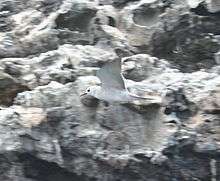Blue noddy
The blue noddy (Anous cerulea) is a seabird in the family Laridae. It is also known as the blue-grey noddy.
| Blue noddy | |
|---|---|
 | |
| Scientific classification | |
| Kingdom: | Animalia |
| Phylum: | Chordata |
| Class: | Aves |
| Order: | Charadriiformes |
| Family: | Laridae |
| Genus: | Anous |
| Species: | A. cerulea |
| Binomial name | |
| Anous cerulea (Bennett, FD, 1840) | |
It is found in American Samoa, the Cook Islands, Fiji, French Polynesia, Kiribati, Marshall Islands, New Caledonia, Samoa, Tonga (Niua), Tuvalu and Hawaii. It has occurred as a vagrant in Australia and Japan. Its natural habitat is open, shallow seas in tropical and subtropical regions.
Taxonomy
The first formal description of the blue noddy was by Frederick Debell Bennett in 1840 under the binomial name Sterna cerulea.[2] The specific name cerulea is Latin for "dark blue".[3]
The blue noddy was formerly placed in the genus Procelsterna. A molecular phylogenetic study published in 2016 found that the five noddies formed a single clade with the blue noddy and the grey noddy in Procelsterna nested between the species in the genus Anous. The authors proposed that the noddies should be merged into a single genus Anous and that Procelsterna should be considered as a junior synonym.[4]
There are five subspecies:[5]
- A. c. saxatilis (Fisher, 1903): Marcus Island & north Marshall Islands to northwest Hawaii
- A. c. cerulea (Bennett, 1840): Kiritimati Island & the Marquesas Islands
- A. c. nebouxi (Mathews, 1912): Phoenix Islands, Tuvalu, Fiji & the Samoan Islands
- A. c. teretirostris (Lafresnaye, 1841):Tuamotu Archipelago, Cook, Austral & Society Islands
- A. c. murphyi (Mougin & Naurois, 1981): Gambier Islands (French Polynesia)
The grey noddy (Anous albivitta) replaces it to the south of its range; the two were formerly considered to be a single species but are now often split.
Description
The blue noddy is 25–28 cm (9.8–11.0 in) in length and has a wingspan of 46–60 cm (18–24 in).[6]
References
- BirdLife International (2012). "Procelsterna cerulea". IUCN Red List of Threatened Species. 2012. Retrieved 26 November 2013.CS1 maint: ref=harv (link)
- Bennett, Frederick Debell (1840). Narrative of a Whaling Voyage Round the Globe, from the year 1833 to 1836. Volume 2. London: Richard Bentley. pp. 248–249.
- Jobling, James A. (2010). The Helm Dictionary of Scientific Bird Names. London: Christopher Helm. p. 83. ISBN 978-1-4081-2501-4.
- Cibois, A.; Thibault, J.-C.; Rocamora, G.; Pasquet, E. (2016). "Molecular phylogeny and systematics of Blue and Grey Noddies (Procelsterna)". Ibis. 158 (2): 433–438. doi:10.1111/ibi.12363.
- Gill, Frank; Donsker, David, eds. (2019). "Noddies, gulls, terns, auks". World Bird List Version 9.2. International Ornithologists' Union. Retrieved 24 June 2019.
- Gochfeld, M.; Burger, J.; Garcia, E.F.J. "Blue Noddy (Procelsterna cerulea)". In del Hoyo, J.; Elliott, A.; Sargatal, J.; Christie, D.A.; de Juana, E. (eds.). Handbook of the Birds of the World Alive. Lynx Edicions. Retrieved 17 April 2017.
